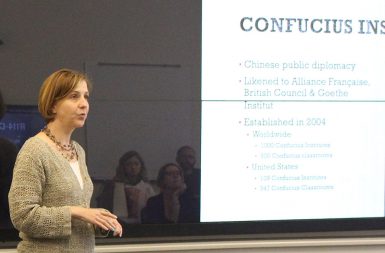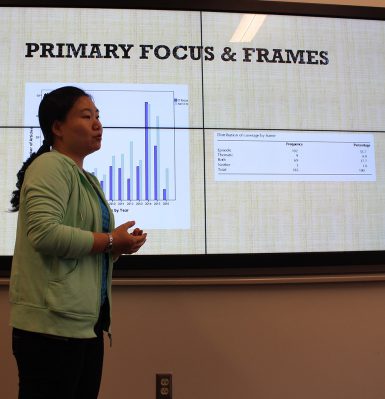Study looks at China’s efforts to improve perceptions

Reports of Chinese Confucius Institutes in the United States can be telling when it comes to studying Chinese-American diplomacy and interactions, associate professor Emily Metzgar and doctoral student Jing Su have found.
Their recent study, “Friends from Afar? American Media Coverage of China’s Confucius Institutes,” was published recently in Journalism Practice. The two researchers presented their findings as part of the Media School’s weekly research talk Sept. 23.
“China famously believes that the American press is anti-China, that American press is negative toward it,” Metzgar said. “Content analyses of American coverage of China, studying, say, The New York Times, have found that to be not necessarily true, but that’s one of China’s big talking points for justifying its massive efforts to improve the way people think about China.”
One way China is trying to change these perceptions is through the Confucius Institutes, a nonprofit, Chinese government-funded educational organization focused on introducing Chinese language and culture in international settings. In the United States, there are more than 100 institutes and 300 associated classrooms.
Metzgar and Jing decided to use the Confucius Institutes as a way to look at the issue of China’s efforts to change how people view the country. They conducted a content analysis, studying 426 articles about these programs over the past 14 years. They focused on 183 articles that look solely at the Institutes themselves.
Jing said the idea for the research came following one of Metzgar’s trips to Beijing as part of the Media School’s travel course, MSCH-J481 Media and Culture in China. (LINK) Jing, a former Chinese as a second language teacher, had a unique position as someone personally connected to the Confucius Institutes. Both were interested because little research had been conducted on the topic.
“Emily said she had the idea that there were not too many studies about the Confucius Institutes, even though there are a lot of Confucius Institutes in the United States,” Jing explained. “I had the background of second language study. My first major was teaching Chinese as a second language, so I used to be a Chinese teacher and I had the connections with the Confucius Institutes.”

Their findings indicated that most of the articles presented the Confucius Institutes in a neutral tone, despite a general Chinese perception that Western media is anti-China.
Audience members questioned this perception during the discussion.
“I’m really curious about why governments blame one another about being anti-other through the use of media,” doctoral student Aysehan Julide Etem said.
“They look for explanations to explain to themselves and to their own people why they might be negatively perceived,” Metzgar said. “And if you look at those American public opinion polls, you can see that the way Americans think about China has declined. And one of the ways to justify that is, ‘Well, American media coverage of China is negative. Therefore, naturally Americans are going to have negative opinions of China.’”
Metzgar said these explanations, even if incorrect, lead directly to decisions like the implementation of the Confucius Institutes and other public diplomacy programs.
Future research for Metzgar and Jing involves looking more closely at the themes appearing in the articles they studied, as well as more specific coding of language: “Try to document specifically who’s being quoted, who’s being cited, what kind of language specifically is being used in these quotes,” Metzgar said.

